One Day in Death Valley – Plan Your Perfect Day
Experience Death Valley in One Day
Death Valley is the largest national park in California. It is filled with incredible things to experience. You can spend several days here and immerse yourself in the park’s treasures. But even if you only have one day, it is worth the trip to experience this magnificent landscape.
It’s a place that inspires reflection on the wonders of our planet. Stepping foot here might make you feel as if you’ve landed on another planet. But you’ll experience the magnificence of earth as never before.
Having visited Death Valley National Park several times, we share tips for travelers who only have one day to experience this great park. It is possible to experience the beauty of Death Valley in just one day.
Our one day Death Valley itinerary will help you make efficient use of your time. The one requirement is a car. Our 1-day schedule will get you to the top sites in Death Valley. With your vehicle, you’ll go on an epic drive to visit sand dunes, salt flats, historical sites, and magnificent vistas.
This blog covers the nine best things to do in Death Valley for a perfect one day Death Valley itinerary. We’re sure that after spending one day in Death Valley, you’ll want to return for more adventures.
The Places Where We Go contains affiliate links and is a member of the Amazon Services LLC Associates Program. As an Amazon Associate, we earn from qualifying purchases at no extra cost to you when you purchase using one of these Amazon links. Read our disclaimer and privacy policy for more information.
Is One Day Enough for a Visit to Death Valley?
At nearly 3.4 million acres, you could spend many days immersed in this geological wonderland. Even though Death Valley is the largest national park in the continental United States, you can get a good sense of the place even if all you have is one day to visit. Mind you; there is no way you’ll see everything. Still, many well-known sites are easy enough to visit by car in a single day.
The key to a successful one-day visit is to prepare a good plan. Keep on reading, and we’ll show you the essentials for your one-day Death Valley visit.
One Day Death Valley Itinerary
You can see quite a bit in just one day within Death Valley. The order of this visit starts on the west side of the park. If you are coming from Las Vegas, you can reverse the order.
Here is our recommended One Day Death Valley Itinerary if you only have one day for your visit.
PRINT: ONE DAY DEATH VALLEY ITINERARY 1 PAGE VERSION
Experience Sunrise at Mesquite Flat Sand Dunes
Driving into Death Valley from the west entrance, one of the first key sites you’ll arrive at is the Mesquite Flat Sand Dunes. This other-worldly location is fantastic to visit at sunrise. As the light shines on the dunes, you’ll experience moments perfect for photography. Early arrival will also ensure you don’t have to battle for a parking space.
You can just step out of your car and enter the dunes area. For a moment, you might think you’re on the other side of the world, wandering in the Sahara Desert. This location is named for the Mesquite Trees, which you’ll see growing in the sandy habitat.
The tallest tune here rises nearly 100 feet. There are no marked trails, but you can wander in as little or as far as you want.
And if you find this dunes location inspiring, check out our post 6 Awesome Death Valley Sand Dunes to learn about more dunes in Death Valley National Park for a future visit.
Recommended Time: 6-8 am (1-2 hours)
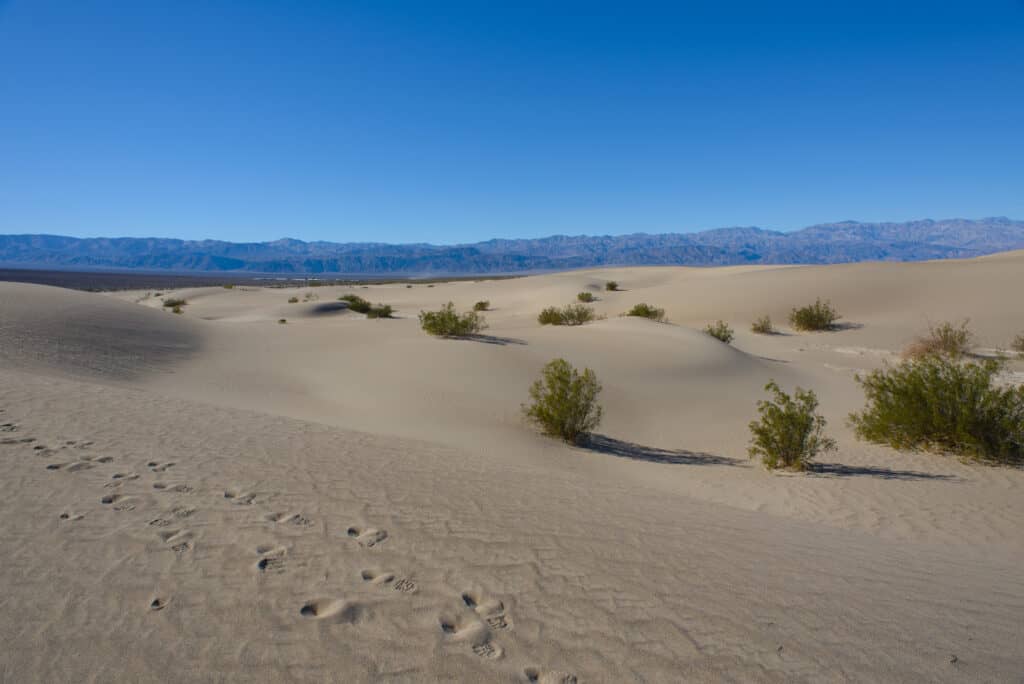
Harmony Borax Works
Get back in your car and drive 24 minutes to the Harmony Borax Works. This is a great place where you can still see remnants of the historic mining operation. Before this place was a National Park, miners would collect borax there. Borax, nicknamed “White Gold of the Desert,” is a white mineral and salt substance used in cosmetics, detergents, and manufactured products.
Back in the day, 20 mule teams hauled wagons across this landscape filled with borax.
You can walk the Harmony Borax Works Interpretive Trail here. It’s a short, easy trail that takes you past an old processing area, rusty equipment, foundations of adobe buildings, and more. Informational displays tell the story of the old borax operation.
During our visit, we were the only people at the site, so it’s possible you can have the place to yourself.
The Harmony Borax Works is listed on the National Register of Historic Places. There is a parking area next to the site. The interpretive trail is an ADA-accessible half-mile loop. Dogs must be on a leash.
There are no restrooms at the Harmony Borax Works site. The closest restroom facility is in the Furnace Creek Visitor Center.
Recommended Time: 830am-9 am (30 minutes)
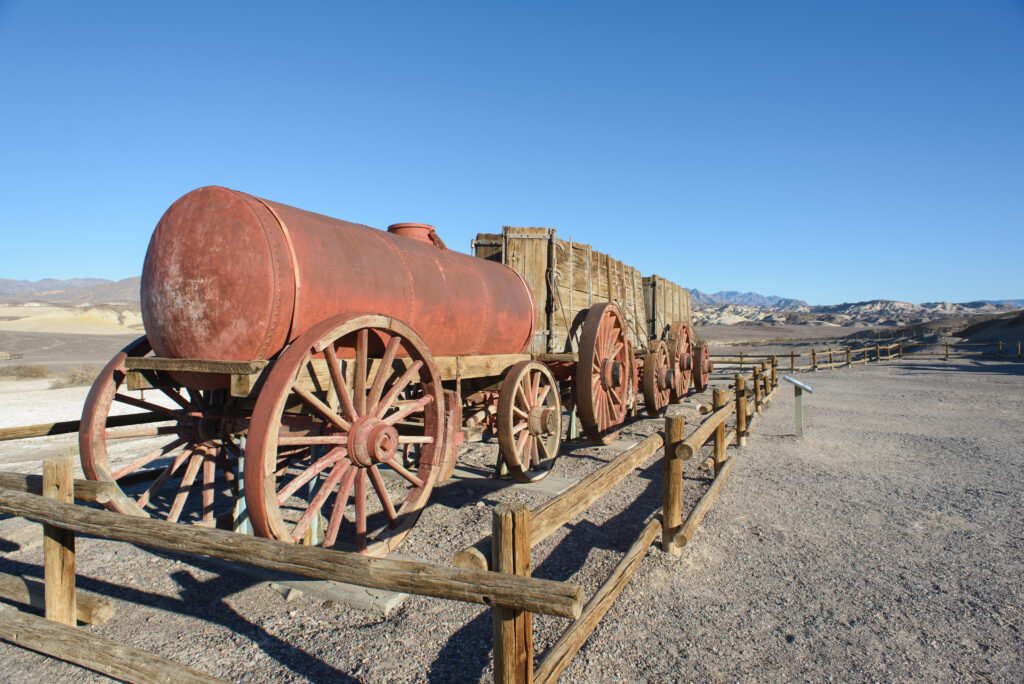
Learn History at the Borax Museum
Our next step is just 5 minutes away – the Borax Museum. A stop here will illuminate the Harmony Borax Works you just visited.
This is a privately-owned museum at The Ranch at Death Valley. The museum is relatively small and located in the oldest structure within the national park. You’ll learn more about borax, a substance only found in the California desert and on the other side of the world in Turkey. The museum covers the history of the borax mining operation and includes historical artifacts, press clippings, photos, tools, and relics representing the Shoshone Indians.
Before you head outside, pick up an information sheet explaining the outdoor items. Behind the museum are more outdoor mining equipment, a stagecoach, and one of only two original Twenty Mule Team Wagons that hauled borax from Death Valley to Mojave. You can get a photo of Old Dinah – a steam wagon that replaces the mule team wagons. Also outside is a Baldwin 280 Locomotive from the Death Valley mining era.
Visitors interested in the history of the old west will surely enjoy a stop at this museum.
Recommended time: 915am – 945am (30 minutes)
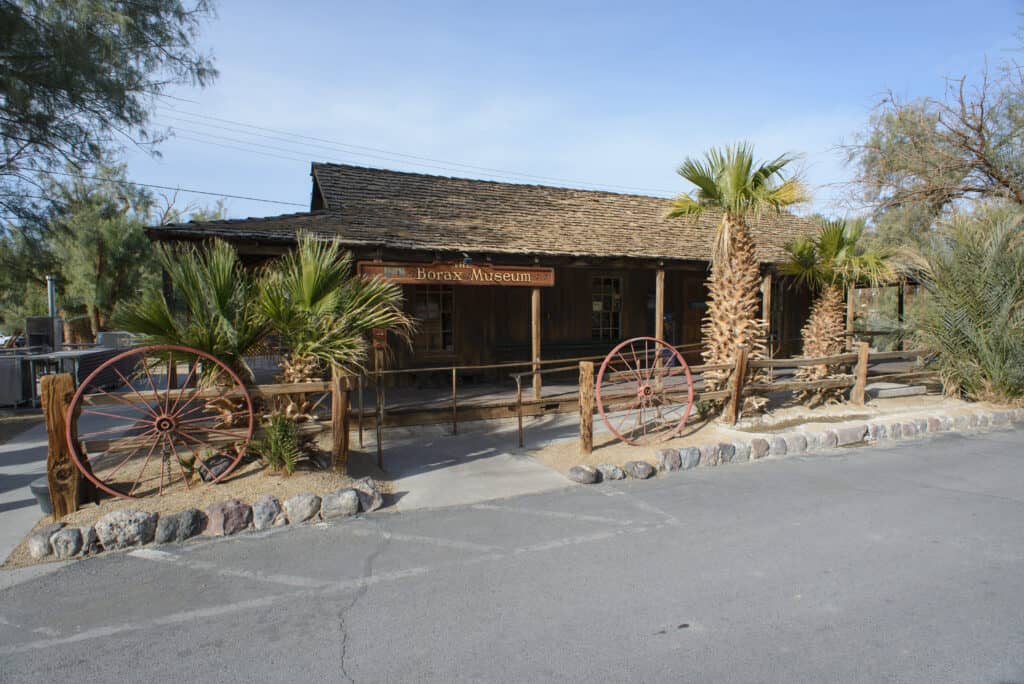
Visit the Furnace Creek Visitor Center
Our next stop is just a three-minute drive – the Furnace Creek Visitor Center.
We always recommend a stop at the National Park Visitor Center. It’s a great place to get the most up-to-date information on current conditions.
The Furnace Creek Visitor Center typically opens at 8 am. You can pay your park entrance fee here if you still need to do so. Maps are available to help with navigation. If you have a refillable water bottle, you can fill it up here. We always stop and chat with the park rangers to get their tips for our visit, be it one day or more in the national park. You can check out the schedule to see if any planned events hosted by the rangers may be of interest to you during your visit.
You can get a National Park Passport Book stamp to document your visit. You can learn more about the park in the visitor center through various exhibits and displays. As in most National Park visitor centers, you’ll find a variety of souvenirs and books.
Note: If you need fuel for your vehicle, one of your only options in the park is nearby the visitor center. Read our Death Valley Gas Stations Guide post for vital information to keep you on the road.
Recommended time: 10am – 1030am (30 minutes)
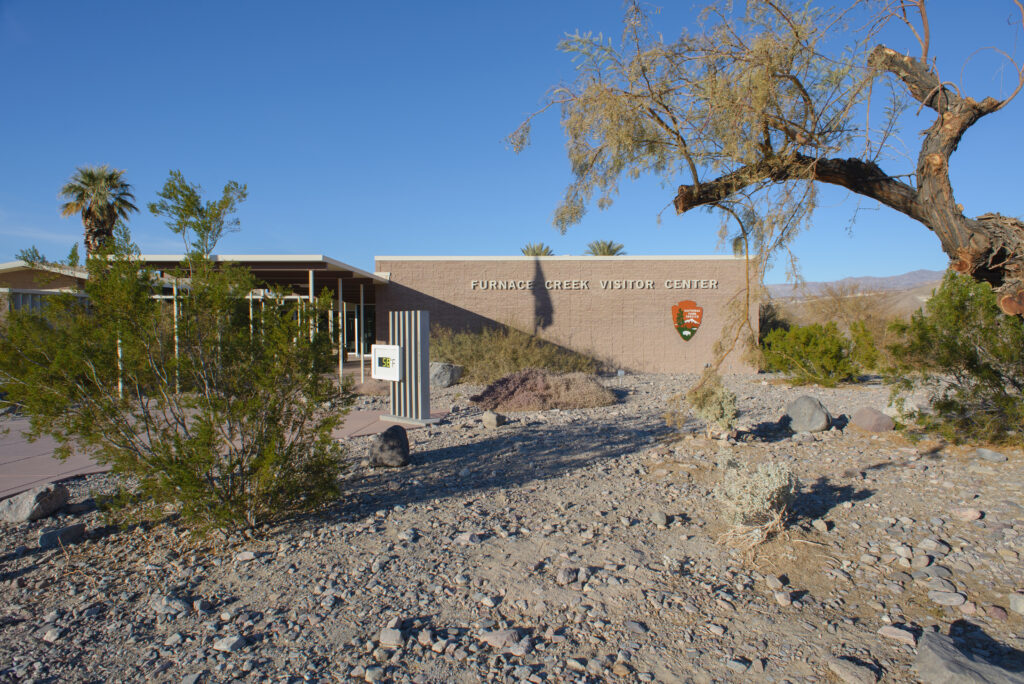
Walk on the Lowest Spot in North America at Badwater Basin
Our next step is a 20-minute drive from the Furnace Creek Visitor Center. We travel south on Highway 190 and make a right on Badwater Road to our next stop. Badwater Basin is the lowest elevation in North America and sits 282 feet below sea level. That’s amazing!
You’ll arrive at the infamous Badwater Basin spot at the southern section of Badwater Road. After parking your car, you can step out to gaze upon an enormous salt pan. Turn around and look behind you up at the mountain, and you’ll catch a glimpse of a sign that marks the spot where the sea level is.
This salt flat area experiences constant change. Salt crystals expand, pushing salt crusts into unique formations through mud cracks. During periods of rain, dust and sediment are washed away, leaving the crusty layers of salt exposed.
There is a trail that you can walk into the basin area. It runs about a half-mile, and should you walk into the salt flat, please stay on the marked trail.
As you walk out further into the salt flat, look down to see unique shapes formed by the salt on the ground. It’s a wonderful place to take photos for sharing with others on social media or for your memories. If you have a DSLR, a wide-angle lens positioned at worm’s eye view can provide some awe-inspiring photographs.
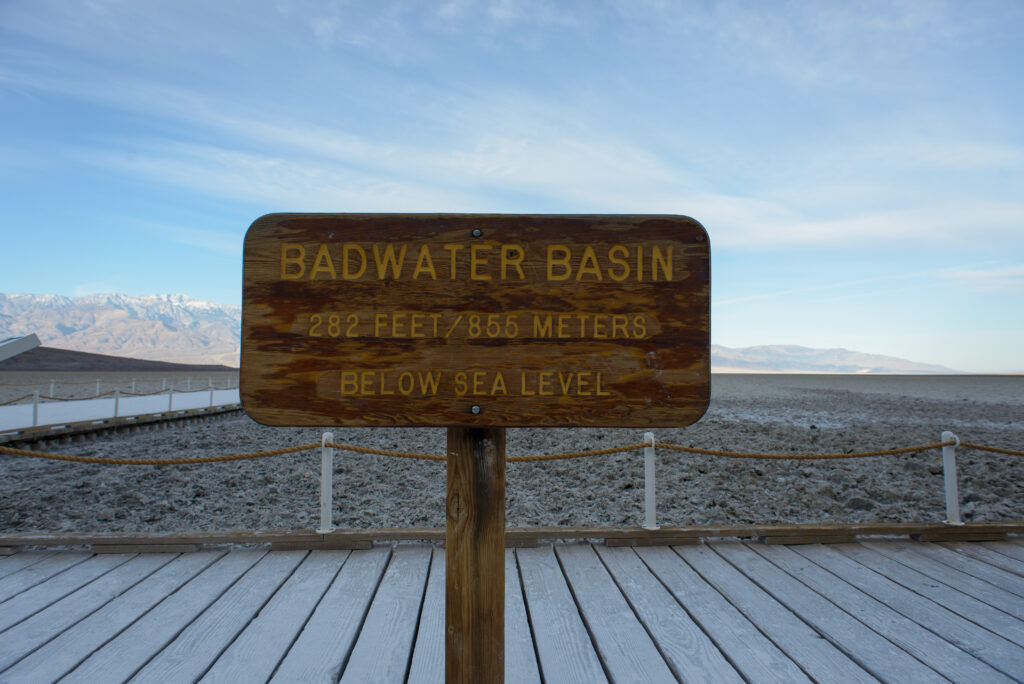
Tips for Visiting Badwater Basin
Time of day: For people who can visit Badwater Basin on a multi-day trip to Death Valley, we recommend scheduling a stop here early in the morning before crowds assemble. We love the solitude that we’ve found here on early morning visits and enjoy seeing the sun start to light up the surrounding area. Many other travelers recommend stopping at Badwater Basin for a.
ch Sun protection: There is no shade in this exposed area. If you are talking out here midday and the temperatures are high, you should have plenty of water for hydration and sun protection for your skin.
Recommended time: 1050am – 12 pm (1 hour, 10 minutes)
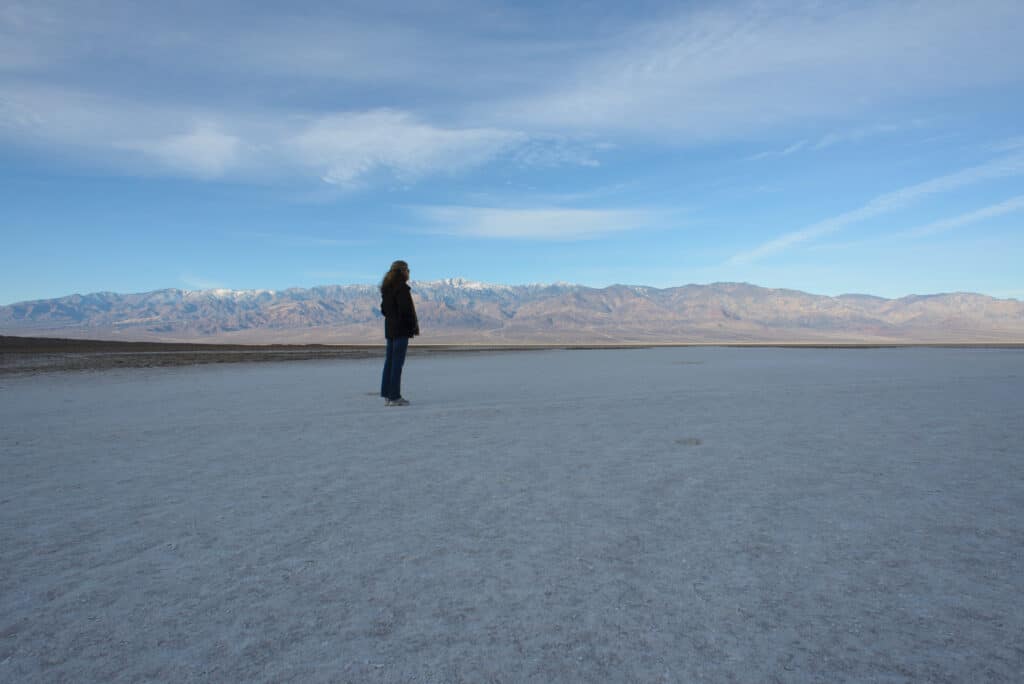
Break For Your Packed Picnic Lunch
We recommend you either pack a lunch before setting out in the morning or grab some food at Stovepipe Wells (during your earlier stop at Mesquite Flat Sand Dunes) for later in the day. In either event, having food and drink in a cooler will be handy as restaurant options are sparse.
Following your trip to Badwater Basin, and hopefully, you scoped out a day without blistering temperatures, we recommend finding a place to have lunch in your car or a pullover spot where you can sit and enjoy lunch outside.
After lunch, continue with the 2nd half of our One Day Death Valley Itinerary.
Recommended time: 12 pm – 1230pm (30 minutes)
Marvel at the Colors on Artist’s Palette Drive
Refreshed with food and drink, our next tour is about 10 minutes back up Badwater Road. Head back up Badwater Road and make a right on Artist’s Road. You’ll follow a loop road through the magnificent Artist’s Palette area.
The nine-mile loop road is a one-way journey. The road entrance is on the southern turnout from Badwater Road and exits a bit further north, back on Badwater Road. There are pull-out areas along the drive as well as some hiking trails.
Entering this zone of the park, you’ll see colors as you’ve never seen before on the rocks, canyons, and mountains. Formed by volcanic minerals, spectacular colors have developed from the effects of heat, water, and time.
The spot called Artist’s Pallette is roughly 4.5 miles into Artist’s Drive. It’s a must-stop and one where you want your best camera with you. At this point, you can view Rainbow Mountain – showing striking blue, green, purple, and yellow hues.
This drive is a leisurely way to experience one of the most scenic spots of this national park.
Recommended time: 1245pm – 115pm (30 minutes for the one-day itinerary – longer on a multi-day itinerary).
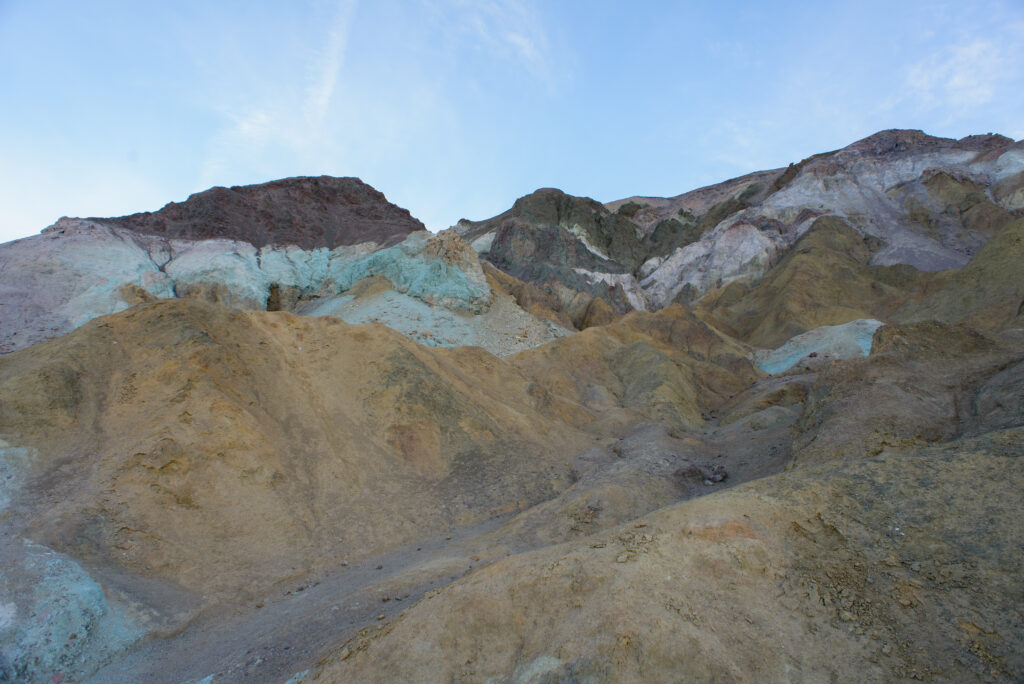
Venture to Devil’s Golf Course
Upon exiting Artist’s Drive, it’s about a 10-minute trip to Devil’s Golf Course. You’ll make a short return trip south on Badwater Road and make a right on West Side Road. The Devil’s Golf Course entrance is not paved, so be ready for a bumpy ride. We made the trek here in our half-ton truck –even with this beast, it was a slow and steady drive.
Because it’s so close to Badwater Basin and Artist’s Drive, it would be a miss not to include this location on your one-day visit. And when you get here, it’s a reminder of the immense geological diversity in the park as the formations here are again different than anything else you’ve seen today.
This is no place for a game of golf or even venturing into the jagged salt formations here. But they are a wonder to behold. It’s a place where you need to be careful. The figures are jagged and sharp and can cause serious injury.
Devil’s Golf Course takes its name from a 1934 National Park Guidebook statement that claimed, “Only the devil could play golf” on this surface.
Recommended time: 130pm – 2 pm (30 minutes)
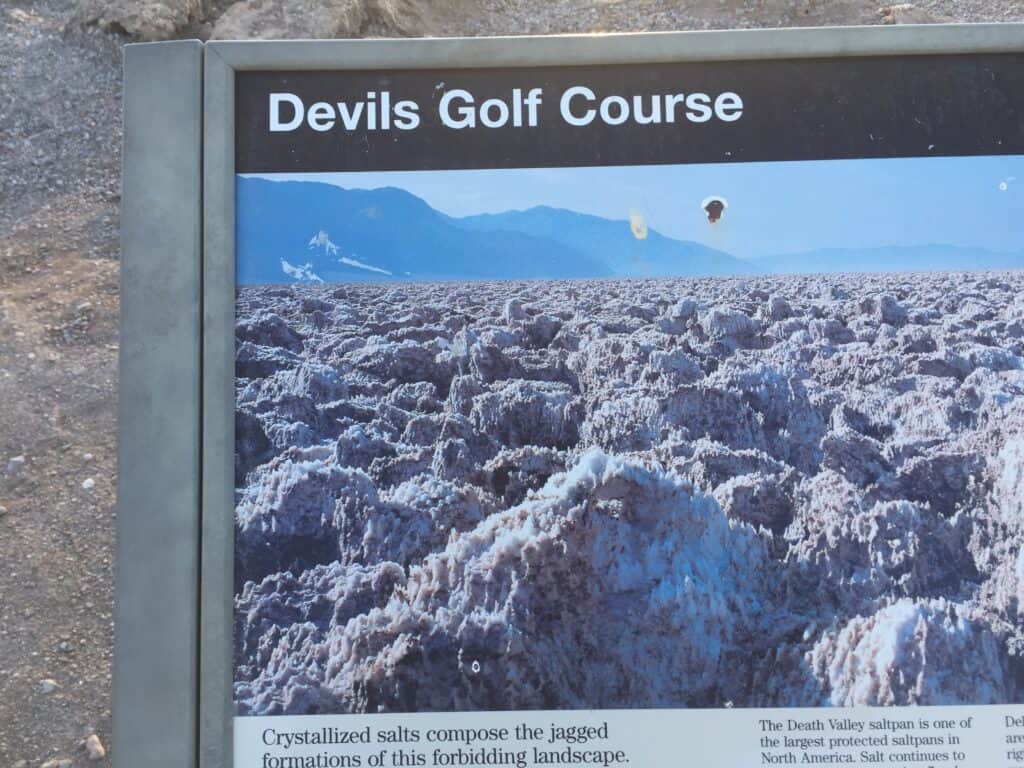
Hike Golden Canyon Trail to the Red Cathedral
A great way to have an immersive experience in a national park is to plan for at least one hike. We recommend the Golden Canyon to Red Cathedral hike for a one-day itinerary.
The trailhead is located approximately 10 minutes north on Badwater Road upon leaving Devil’s Golf Course.
Of course, be mindful of the time of year and temperature should you embark on this hike. Our recommendation for this hike is subject to conducive conditions. It can get very hot on this trail during the middle of the day. It’s a recommended hike between October through March. Parking can also be a challenge here.
This out-and-back trail is located just below Zabriskie Point, our final recommended stop on our one-day itinerary. You’ll see stunning rock formations on the path. There are a few gentle scrambles – basically some small step-ups on the path.
Trail information:
Difficulty: Moderately challenging
Length: 2.9 miles
Elevation Gain: 574 feet
Recommended time: 215pm – 415pm (2 hours)
Watch Sunset at Zabriskie Point
Our final stop for a one-day Death Valley itinerary is Zabriskie Point. It’s about a 9-minute drive here from the Golden Canyon Trailhead.
This is an excellent spot for sunrise and sunset – and we choose to end a one-day trip at this beautiful spot.
From the parking lot, you make a short walk up an incline to the vista area. The sweeping views are beautiful and otherworldly. Here, you can admire impressive panoramic views of the Death Valley badlands. The badlands area was covered by water millions of years ago. The mountains display golden, brown, and chocolate hues that take on a picturesque aura as the descending sun moves its light across this desert field.
Sunset at Zabriskie Point – it’s another spot where you’ll be inspired to take photographs.
Recommended time: 430 – 530pm (1 hour)
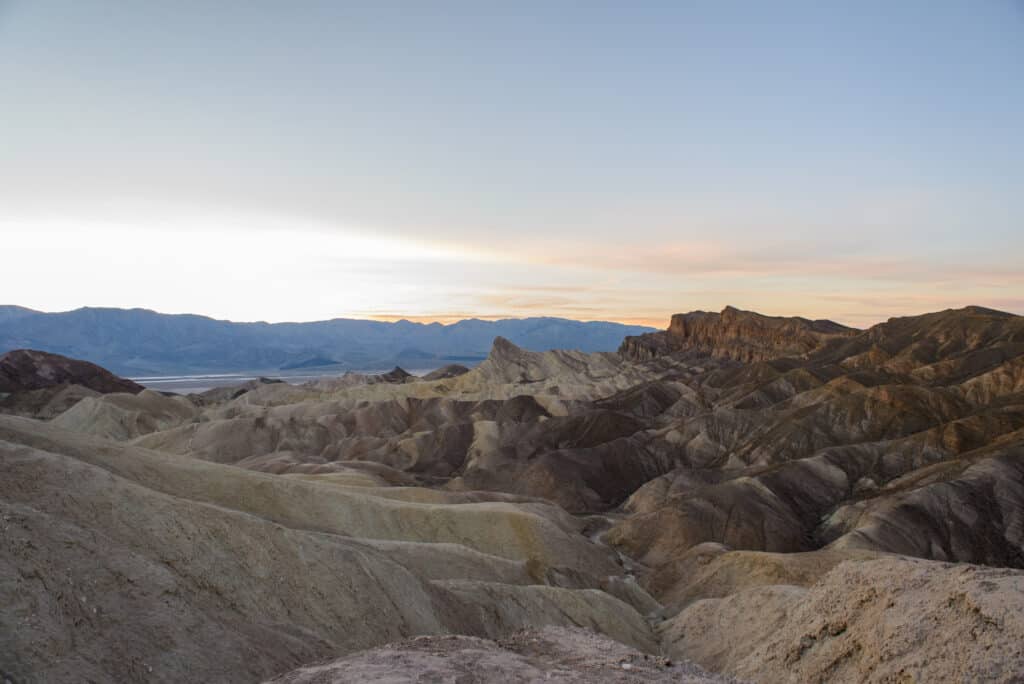
PRINT: ONE DAY DEATH VALLEY ITINERARY 1 PAGE VERSION
One Day Death Valley Itinerary Map
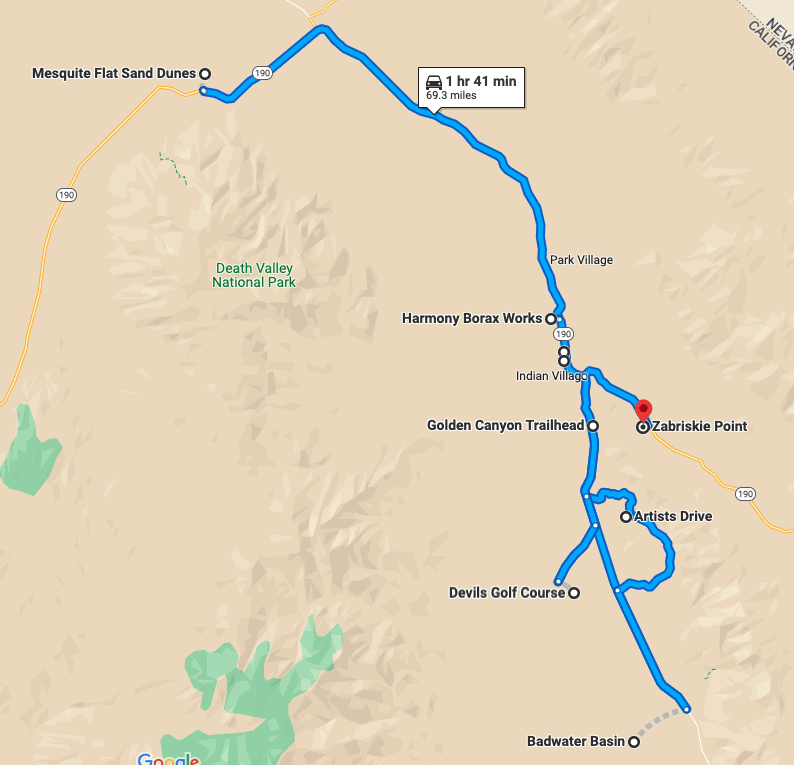
Dinner in Death Valley
If you choose to have dinner in Death Valley at the end of your day, you might try Last Kind Words Saloon & Steakhouse. This restaurant is located inside The Oasis at Death Valley.
The ambiance inside is of an old west saloon adorned with relics of movie posters, wanted posters of outlaws, and antique firearms.
Dinner options vary, span barbecued ribs, wild Alaskan salmon, and pasta. The bar provides accompaniments of beer, wine, or whiskeys.
Dinner reservations are highly recommended and can be made up to three months in advance by calling 760-786-3335.
Where is Death Valley?
Death Valley National Park is found mainly in Inyo County, California, near the border of California and Nevada in the Great Basin. Death Valley is primarily in California, with a section spilling into Nevada.
A north-to-south view has the Amargosa Range on its east side and the Panamint Range on the park’s west side. The northern border is the Grapevine Mountains, while the southern section includes the Owlshead Mountains.
What’s So Special About Death Valley?
In southeast California, next to the Nevada border, the area of land called Death Valley is the lowest elevation, hottest temperature, and driest place in North America.
Is Death Valley Worth Visiting?
Hopefully, you can tell from the descriptions of our one day Death Valley itinerary that there is much to see.
This national park is unlike any other and is absolutely worth visiting. Within a 10-minute drive from one location to another, you can see unique views of this landscape. From colorful mountains to salt-crusted formations on the basin floor to historical remnants of an old western mining area, this fantastic park is a gem.
By all means, plan a visit to Death Valley National Park – even if all you have is one day.
When is the Best Time to Visit Death Valley?
During our first visit to Death Valley National Park, we talked with a waitress at a restaurant in Furnace Park to inquire about the seasons and visitors. We were sure that winter was the peak season, as that was when we planned our trip. Interestingly, she mentioned that foreign tourists often make a point to experience summer’s harsh temperatures in the park. That said, we recommend you not visit Death Valley during summer.
We’ve made several trips to the park during winter. It is a wonderful time of year. Even if you have to layer for the cold, you’ll be able to stay out all day long and keep exploring. Know that the weeks surrounding Christmas tend to attract more crowds during the winter season.
Spring is also a decent time to visit. Temperatures start warming up, so it’s a good idea to check the forecast before arrival. If California experienced decent rain leading up to summer, you might even witness the super bloom which is quite a fantastic desert event.
Spring and Autumn temperatures can still reach the 90s here. So pay attention to your weather app.
Summer is just plain difficult. With some of the hottest temperatures on the planet, you’ll have limited time for exploring the outdoors. It is challenging to stay hydrated, and you’ll risk a medical situation if you don’t play your cards right. With the thermometer possibly exceeding 120 degrees Fahrenheit during summer, it’s no fun exploring a place that feels like an oven.
Besides the time of year, think about the days of the week you choose for a visit. Weekends tend to be more crowded, so if you’re able to come on a weekday, you can likely be at places in the park as we have and feel like you have the place to yourself.
In summary, the best time to visit Death Valley is between November and March.
Entrance Fees for Death Valley National Park
Like most National Parks, you’ll be required to pay an entrance fee at this location. You can pay your fee through the following options:
Seven-Day Pass: Cost $30 for a vehicle and $25 for a motorcycle. All persons who travel with the permit holder can leave and re-enter the park as often as needed during the seven days.
America the Beautiful Pass: Cost $80. Valid for one year. Provides entrance to the national park system and other federal fee areas. This is your best bet if you plan to visit multiple national parks during the year.
Lifetime Senior Pass: Cost $80. For seniors over the age of 62. Additional payment options (4th-grade pass, military pass, etc.) are listed on the Death Valley National Park website.
In-person payment locations for Death Valley National Park during regular business hours;
- Furnace Creek Visitor Center
- Stovepipe Wells Ranger Station
- Lone Pine Interagency Visitor Center (Interagency Annual Pass ONLY)
- Furnace Creek Campground kiosk (when staffed from October 15 to April 15)
The park service prefers payment via credit or digital payments. You’ll find electronic payment machines at most entrance points to the park. Kiosk locations include:
- Furnace Creek Visitor Center
- Stovepipe Wells Ranger Station
- Grapevine Ranger Station
- Ryan Kiosk (east entrance to park on Hwy 190)
- Zabriskie Point
- Hell’s Gate (Daylight Pass Road)
- Furnace Creek Campground (April 16 to October 14)
- Sunset Campground (when open)
- Texas Springs Campground (when open)
- Stovepipe Wells Campground (when open)
- Mesquite Springs Campground
Your entrance fee can also be purchased at Recreation.gov.
Unlike other National Parks with a physical entrance gate where you pay your fee, it’s somewhat on the honor system in Death Valley.
As the National Parks are so important, please do your part to support the park service during your visit. Visit the Death Valley National Park Website for the latest information on fees.
How to Get to Death Valley National Park
You will need a car to see Death Valley. One alternative is to book a one-day tour from Las Vegas, located about 2-hours away.
The main road running through Death Valley National Park is Highway 190.
Arriving from the west (Los Angeles): I-5 N to CA-14 N to US-395 N to CA-190 E.
It is approximately 4 hours from Los Angeles to Death Valley National Park.
Arriving from the east (Las Vegas): Highway 95 to Highway 374 to Highway 190.
It is approximately 2 hours from Las Vegas to Death Valley National Park.
Car Rental: Reduce travel stress by booking your car rental before your arrival.
Driving in Death Valley National Park
Overall, Death Valley includes nearly 1,000 miles of roads. Many of these are unpaved roads that provide access to remote locations.
There are a few main roads in Death Valley National Park. It’s helpful to become familiar with the road layout before you arrive.
Here are the main roads you’ll want to be familiar with for your visit – and they are the only roads you’ll need to travel during your one-day adventure in Death Valley:
- California 190 (CA-190) divides the park from east to west
- Badwater Road, runs north-south from Furnace Creek to Badwater Basin.
- Artist’s Drive,is a picturesque loop from Badwater Road that meanders through the scenic Artist’s Palette area.
Parking in Death Valley
You’re likely to get parking in most places within the park. Though for more popular spots such as Zabriskie Point and Badwater Basin, it helps to arrive early.
Packing For Your Death Valley Day Trip
You’ll have a better experience if you come prepared for your one day Death Valley itinerary visit. Here is our minimum list of recommended items to bring with you for your visit.
- Clothing – Sweat-wicking shirts work well here. Light hiking pants are a good choice. You might even want to pack an extra pair of socks if you plan to walk on the dunes.
- Credit / Debit card
- Food – Prepare a picnic lunch in advance of your visit and bring snacks for the day
- Cooler with ice packs to keep your food cold
- Day pack to hold drinks and snacks as you visit the sites.
- Hydration – Bring plenty of drinking water and a reusable water bottle (you can fill it up for free at the visitor center). We recommend one gallon per person.
- Jacket – Even though Death Valley is known for its heat, the off-season can be cool and even chilly at night.
- Jumper cables – With auto service hard to find, a set of jumper cables can come in handy
- Map – It’s a good idea to have a physical map as well as pre-downloaded maps of Death Valley National Park on your smartphone
- Photography equipment – If you have a good camera, this is the place to bring it. We like a wide-angle lens in this park if you choose only one to bring with you.
- Shoes – bring comfortable hiking shoes that can handle the rugged landscape
- Sun protection – Bring sunscreen, sunglasses, and a hat
- Vehicle preparation – have jumper cables with you and be aware of the gas station situation inside Death Valley National Park
Get Our Free Death Valley Packing Checklist
Things To Know For Your Death Valley trip
Be aware of the lay of the land. Study a map before your trip and plan your route.
Your Car – Be sure your car is in good operating condition before you trip (e.g., oil changed, tire pressure checked, spare tire available, cooling system prepared)
Gas is limited and expensive. Fill up your tank before you enter the park. Read our post on gas stations – Death Valley Gas Stations Guide to Keep You On The Road.
Pets are only allowed along roads, in campgrounds and picnic areas, and in developed areas – and only if on a leash. Pets are not permitted on hiking trails, inside buildings, or out in the open throughout the park.
✈️ Closest Airport: Las Vegas McCarren (LAS)
⏰ Time Zone: Pacific Standard Time (GMT-8)
Book A Flight Near Death Valley Through Expedia
Plan Your Lunch Before Your Trip
This one day Death Valley itinerary sets you near Badwater Basin close to the lunch hour. There is no restaurant that serves lunch in this area.
For your lunch, your options include:
- You can just pack lunch with you before you leave on this trip. You can then enjoy a picnic lunch at a pullover location, or
- Buy food in Stovepipe Wells as you exit Mesquite Flat Sand Dunes. You’ll want to find something you can keep for lunch. A cooler with ice is recommended. Warning – early everything costs more in Death Valley than outside the park. So if you buy groceries or food here, don’t be too surprised at the cost.
Can I Just Drive Through Death Valley?
Yes. If you don’t want to get out of your car, it is possible to appreciate the landscape from the comfort of your vehicle. A drive through Death Valley National Park along Highway 190 is epic. You can whiz past some of the key sites we’ve listed on our one-day itinerary.
The places you’ll want to drive past include:
- Mesquite Sand Dunes – you can stop in the parking lot and take in a view from your car
- Badwater Basin – the drive here will give you a view from your vehicle of the lowest spot in North America
- Artists Palette – this scenic drive is probably the highlight of a drive through Death Valley National Park
What Should You Not Miss In Death Valley?
If you want to further refine the stops from our recommended one-day itinerary to an even smaller list of just the essentials, we would emphasize the following five Death Valley attractions as must-stops for your one-day visit:
- Mesquite Sand Dunes
- Badwater Basin
- Artist’s Palette
- Devil’s Golf Course
- Zabriskie Point
Where To Stay For Your Death Valley visit
Lodging options include a few places inside Death Valley National Park and towns on the park’s perimeter. Campers also have several campgrounds from which to select. Read on for some top choices.
Where To Stay In Death Valley – 18 Top Places
Hotels in/near Death Valley National Park
Lodging options are limited in Death Valley. For a one-day trip, it is worth looking at options just beyond the borders of the national park to get better rates.
Here are some top lodging options to consider for your trip:
The Oasis at Death Valley – This location has two hotels – The Inn at Death Valley and The Ranch at Death Valley. As rooms sell out months in advance, call for reservations when you decide to schedule your future visit.
The Inn at Death Valley is your most upscale option inside the park. Get ready to be pampered with amenities that include a sauna and spa treatments. Additional features include a gym, swimming pool, several restaurants on the premises, and tennis courts.
Click To Stay At The Inn at Death Valley
The Ranch at Death Valley – This is a more moderately priced and family-friendly option in the park. Features include a playground, sports courts, fire pits, a swimming pool, and restaurants.
Click To Stay At The Ranch at Death Valley
Panamint Springs Resort – Located on the park’s west side, this budget-friendly option offers cabin-style motel rooms. The resort includes a restaurant on the grounds. You can bring your dog to this location.
Click To Stay At Panamint Springs Resort
Staying Outside of Death Valley
During one of our visits to Death Valley National Park, we stayed outside the east entrance at the Longstreet Inn and Casino and RV Park in Nevada. It’s a 40-minute drive from this location to the Furnace Creek Visitor Center.
Other locations to consider for a stay outside the park include:
- Beatty Nevada (east of the park)
- Pahrump / Death Valley Junction (east of the park)
- Panamint (west of the park)
Camping In/Near Death Valley National Park
Camping is another option for a visit to Death Valley. The park has nine campgrounds. Some of the campgrounds are only available during specific months of the year. Check the Death Valley National Park Website for current info on campgrounds.
We brought our Airstream to the Longstreet Inn and Casino and RV Park in Amargosa, Nevada. This was a good option as it provided RV hookups and was reasonably priced.
Death Valley Highlights Video
Watch our YouTube video for highlights from one of our trips to Death Valley National Park.
Death Valley Podcast
Check out our episodes on Death Valley National Park if you enjoy podcasts. You can listen here or download from your favorite podcast service.
10 Things To Do In Death Valley (Part 1) [podcast]
10 Things To Do In Death Valley (Part 2) [podcast]
Thanks for reading our One Day Death Valley Itinerary!

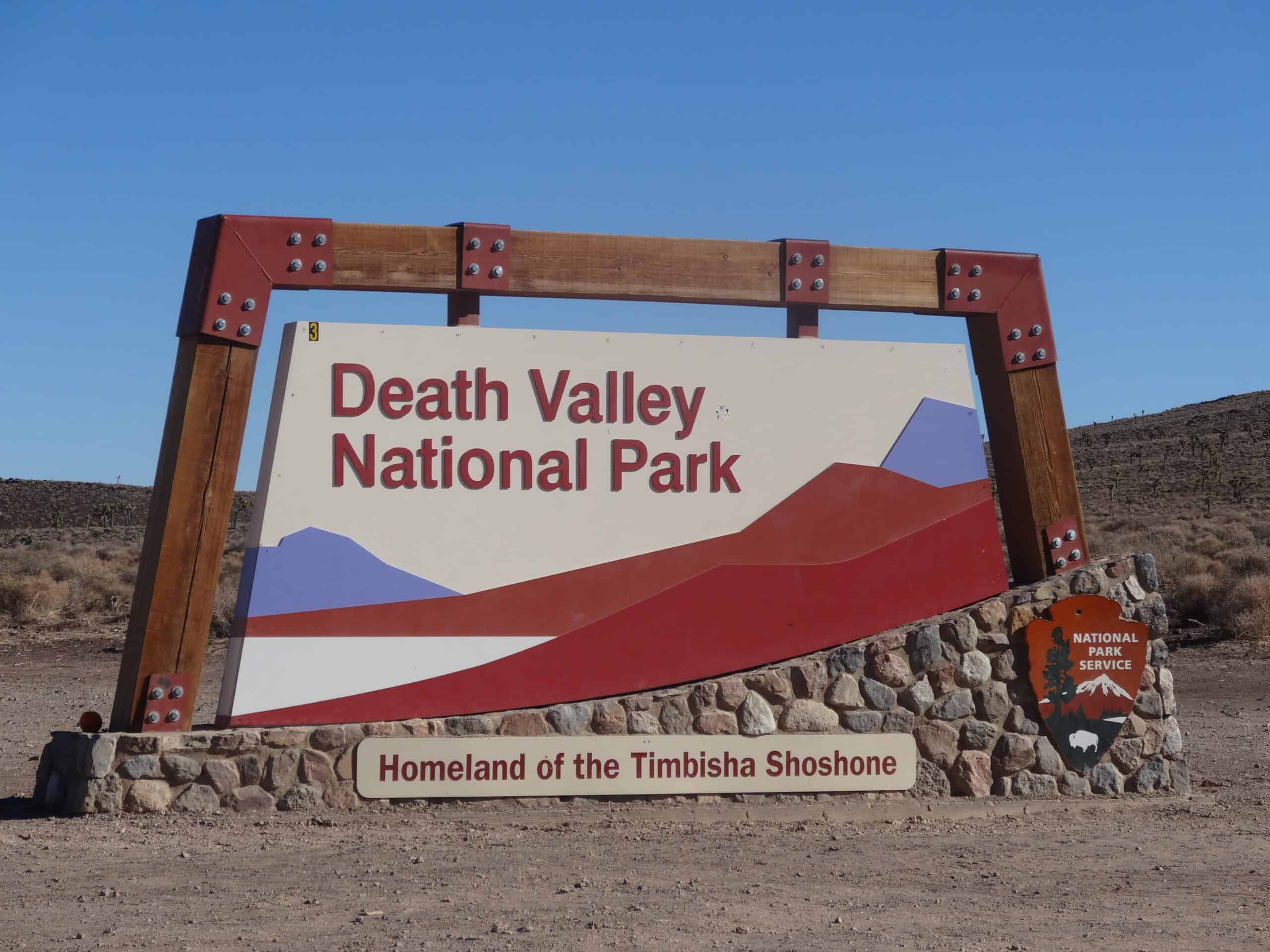
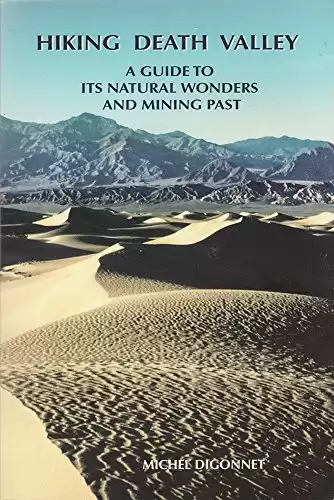
12 Comments
Comments are closed.